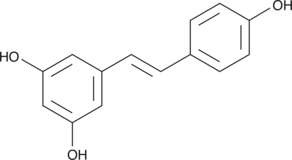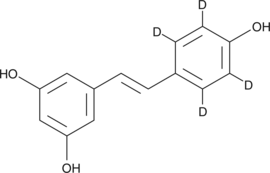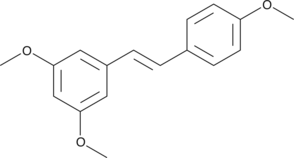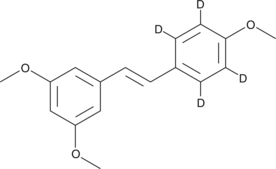Chemicals
Showing 38551–38700 of 41137 results
-
trans-2-Decenoic acid is an unsaturated fatty acid found in royal jelly produced from the hypopharyngeal and mandibular gland secretions of honeybees. It is isolated in conjunction with 10-HDA (Item No. 10976) and both demonstrate weak estrogenic activity, inhibiting binding of 17β-estradiol (Item No. ISO60155) to estrogen receptor β.{29007}
Brand:CaymanSKU:-Available on backorder
trans-2-Decenoic acid is an unsaturated fatty acid found in royal jelly produced from the hypopharyngeal and mandibular gland secretions of honeybees. It is isolated in conjunction with 10-HDA (Item No. 10976) and both demonstrate weak estrogenic activity, inhibiting binding of 17β-estradiol (Item No. ISO60155) to estrogen receptor β.{29007}
Brand:CaymanSKU:-Available on backorder
trans-2-Decenoic acid is an unsaturated fatty acid found in royal jelly produced from the hypopharyngeal and mandibular gland secretions of honeybees. It is isolated in conjunction with 10-HDA (Item No. 10976) and both demonstrate weak estrogenic activity, inhibiting binding of 17β-estradiol (Item No. ISO60155) to estrogen receptor β.{29007}
Brand:CaymanSKU:-Available on backorder
trans-2-Octenoyl-L-carnitine is a synthetic carnitine.{52671} It has been used as a standard for the detection of carnitines in human urine.
Brand:CaymanSKU:30995 - 1 mgAvailable on backorder
trans-2-Octenoyl-L-carnitine is a synthetic carnitine.{52671} It has been used as a standard for the detection of carnitines in human urine.
Brand:CaymanSKU:30995 - 10 mgAvailable on backorder
trans-2-Octenoyl-L-carnitine is a synthetic carnitine.{52671} It has been used as a standard for the detection of carnitines in human urine.
Brand:CaymanSKU:30995 - 5 mgAvailable on backorder
trans-3’-Hydroxycotinine (3HC) is a product of CYP2A6 metabolism of the primary nicotine metabolite, cotinine (Item No. 15314).{26187,26185} Cotinine has a longer metabolic half-life compared to 3HC (16 hours vs. 5 hours).{26187} The ratio of 3HC to cotinine, termed the nicotine metabolite ratio, correlates with nicotine clearance from the body and is used as a biomarker of CYP2A6 activity.{26187} This measure of nicotine metabolism has been used to study tobacco and secondhand smoke exposure as well as to develop pharmacological intervention strategies for smoking cessation.{26187,26186}
Brand:CaymanSKU:-trans-3’-Hydroxycotinine (3HC) is a product of CYP2A6 metabolism of the primary nicotine metabolite, cotinine (Item No. 15314).{26187,26185} Cotinine has a longer metabolic half-life compared to 3HC (16 hours vs. 5 hours).{26187} The ratio of 3HC to cotinine, termed the nicotine metabolite ratio, correlates with nicotine clearance from the body and is used as a biomarker of CYP2A6 activity.{26187} This measure of nicotine metabolism has been used to study tobacco and secondhand smoke exposure as well as to develop pharmacological intervention strategies for smoking cessation.{26187,26186}
Brand:CaymanSKU:-trans-3’-Hydroxycotinine (3HC) is a product of CYP2A6 metabolism of the primary nicotine metabolite, cotinine (Item No. 15314).{26187,26185} Cotinine has a longer metabolic half-life compared to 3HC (16 hours vs. 5 hours).{26187} The ratio of 3HC to cotinine, termed the nicotine metabolite ratio, correlates with nicotine clearance from the body and is used as a biomarker of CYP2A6 activity.{26187} This measure of nicotine metabolism has been used to study tobacco and secondhand smoke exposure as well as to develop pharmacological intervention strategies for smoking cessation.{26187,26186}
Brand:CaymanSKU:-trans-4-hydroxy L-Proline is a non-essential amino acid that is commonly used as a chiral building block in the organic synthesis of various compounds.{43500} It is a constituent of collagen and elastin and has been found in many bacterial secondary metabolites, including echinocandins.
Brand:CaymanSKU:26061 - 10 gAvailable on backorder
trans-4-hydroxy L-Proline is a non-essential amino acid that is commonly used as a chiral building block in the organic synthesis of various compounds.{43500} It is a constituent of collagen and elastin and has been found in many bacterial secondary metabolites, including echinocandins.
Brand:CaymanSKU:26061 - 25 gAvailable on backorder
trans-4-hydroxy L-Proline is a non-essential amino acid that is commonly used as a chiral building block in the organic synthesis of various compounds.{43500} It is a constituent of collagen and elastin and has been found in many bacterial secondary metabolites, including echinocandins.
Brand:CaymanSKU:26061 - 50 gAvailable on backorder
trans-4-phenyl-4-Piperidinocyclohexanol (Item No. 20565) is an analytical reference standard that is structurally categorized as an arylcyclohexylamine. It is a metabolite of phencyclidine (PCP; Item No. ISO60194).{32956} trans-4-phenyl-4-Piperidinocyclohexanol inhibits dopamine uptake in rat striatal synaptosomes to a similar extent as PCP.{32955} This product is intended for research and forensic applications.
Brand:CaymanSKU:20565 -Available on backorder
Polyunsaturated fatty acids such as arachidonate and linoeate, while essential to health maintenance, are subject to random peroxidation by ambient oxygen, resulting in fragmented and reactive decomposition products. One prominent autoxidation product of either trilinolein or arachidonic acid is trans-4,5-epoxy-2(E)-decenal. This aldehyde is responsible for a pungent metallic flavor of decomposed lipids, with a detection threshold of 1.5 pg/l in air.{12852} trans-4,5-epoxy-2(E)-Decenal also reacts with nucleophiles (lysine amino groups) on proteins, leading to loss of cell function and viability.{12851} This reactive aldehyde is therefore a useful tool in elucidating the effects of peroxidative damage in experimental models.
Brand:CaymanSKU:10004257 - 1 mgAvailable on backorder
Polyunsaturated fatty acids such as arachidonate and linoeate, while essential to health maintenance, are subject to random peroxidation by ambient oxygen, resulting in fragmented and reactive decomposition products. One prominent autoxidation product of either trilinolein or arachidonic acid is trans-4,5-epoxy-2(E)-decenal. This aldehyde is responsible for a pungent metallic flavor of decomposed lipids, with a detection threshold of 1.5 pg/l in air.{12852} trans-4,5-epoxy-2(E)-Decenal also reacts with nucleophiles (lysine amino groups) on proteins, leading to loss of cell function and viability.{12851} This reactive aldehyde is therefore a useful tool in elucidating the effects of peroxidative damage in experimental models.
Brand:CaymanSKU:10004257 - 10 mgAvailable on backorder
Polyunsaturated fatty acids such as arachidonate and linoeate, while essential to health maintenance, are subject to random peroxidation by ambient oxygen, resulting in fragmented and reactive decomposition products. One prominent autoxidation product of either trilinolein or arachidonic acid is trans-4,5-epoxy-2(E)-decenal. This aldehyde is responsible for a pungent metallic flavor of decomposed lipids, with a detection threshold of 1.5 pg/l in air.{12852} trans-4,5-epoxy-2(E)-Decenal also reacts with nucleophiles (lysine amino groups) on proteins, leading to loss of cell function and viability.{12851} This reactive aldehyde is therefore a useful tool in elucidating the effects of peroxidative damage in experimental models.
Brand:CaymanSKU:10004257 - 5 mgAvailable on backorder
Soluble epoxide hydrolase (sEH) converts epoxides to their corresponding diols. Inhibitors of sEH have anti-inflammatory, anti-hypertensive, neuroprotective, and cardioprotective effects.{14072,12607} trans-AUCB is a very potent inhibitor of sEH (IC50 = 0.5 nM).{19484} It displays high oral bioavailability for doses ranging from 0.01 to 1 mg/kg.{20116,17571} Dual inhibition of COX-2 and sEH, by celecoxib (Item No. 10008672) and trans-AUCB, suppresses tumor angiogenesis, inhibiting tumor growth and metastasis in a Lewis lung carcinoma model in mice.{26684}
Brand:CaymanSKU:-Out of stock
Soluble epoxide hydrolase (sEH) converts epoxides to their corresponding diols. Inhibitors of sEH have anti-inflammatory, anti-hypertensive, neuroprotective, and cardioprotective effects.{14072,12607} trans-AUCB is a very potent inhibitor of sEH (IC50 = 0.5 nM).{19484} It displays high oral bioavailability for doses ranging from 0.01 to 1 mg/kg.{20116,17571} Dual inhibition of COX-2 and sEH, by celecoxib (Item No. 10008672) and trans-AUCB, suppresses tumor angiogenesis, inhibiting tumor growth and metastasis in a Lewis lung carcinoma model in mice.{26684}
Brand:CaymanSKU:-Out of stock
Soluble epoxide hydrolase (sEH) converts epoxides to their corresponding diols. Inhibitors of sEH have anti-inflammatory, anti-hypertensive, neuroprotective, and cardioprotective effects.{14072,12607} trans-AUCB is a very potent inhibitor of sEH (IC50 = 0.5 nM).{19484} It displays high oral bioavailability for doses ranging from 0.01 to 1 mg/kg.{20116,17571} Dual inhibition of COX-2 and sEH, by celecoxib (Item No. 10008672) and trans-AUCB, suppresses tumor angiogenesis, inhibiting tumor growth and metastasis in a Lewis lung carcinoma model in mice.{26684}
Brand:CaymanSKU:-Out of stock
Soluble epoxide hydrolase (sEH) converts epoxides to their corresponding diols. Inhibitors of sEH have anti-inflammatory, anti-hypertensive, neuroprotective, and cardioprotective effects.{14072,12607} trans-AUCB is a very potent inhibitor of sEH (IC50 = 0.5 nM).{19484} It displays high oral bioavailability for doses ranging from 0.01 to 1 mg/kg.{20116,17571} Dual inhibition of COX-2 and sEH, by celecoxib (Item No. 10008672) and trans-AUCB, suppresses tumor angiogenesis, inhibiting tumor growth and metastasis in a Lewis lung carcinoma model in mice.{26684}
Brand:CaymanSKU:-Out of stock
trans-Clovamide is a naturally occurring caffeoyl conjugate identified in the antioxidant polyphenolic fraction of cocoa (T. cacao L.).{26477} It has antioxidant and antiradical properties and has shown neuroprotective effects (EC50s = 0.9-3.7 µM) in several in vitro models of neuronal death.{26478}
Brand:CaymanSKU:-trans-Clovamide is a naturally occurring caffeoyl conjugate identified in the antioxidant polyphenolic fraction of cocoa (T. cacao L.).{26477} It has antioxidant and antiradical properties and has shown neuroprotective effects (EC50s = 0.9-3.7 µM) in several in vitro models of neuronal death.{26478}
Brand:CaymanSKU:-trans-Clovamide is a naturally occurring caffeoyl conjugate identified in the antioxidant polyphenolic fraction of cocoa (T. cacao L.).{26477} It has antioxidant and antiradical properties and has shown neuroprotective effects (EC50s = 0.9-3.7 µM) in several in vitro models of neuronal death.{26478}
Brand:CaymanSKU:-trans-Clovamide is a naturally occurring caffeoyl conjugate identified in the antioxidant polyphenolic fraction of cocoa (T. cacao L.).{26477} It has antioxidant and antiradical properties and has shown neuroprotective effects (EC50s = 0.9-3.7 µM) in several in vitro models of neuronal death.{26478}
Brand:CaymanSKU:-During oxidative stress, the abundant unsaturated fatty acid linoleic acid undergoes lipid peroxidation to produce α,β-unsaturated epoxy-keto-octadecenoic acids (EKODEs). Nonenzymatic autooxidation of linoleic acid generates six major EKODE isomers, which differ from one another in the positioning and the orientation of the epoxy group relative to the keto moiety. trans-EKODE-(E)-Ib is a biologically active peroxidation product of linoleic acid that is characterized, structurally, by having a trans carbon-carbon double bond between the 9-keto and 12,13-epoxy groups. It activates an antioxidant response element (ARE) in neuronal cells and induces the expression of ARE-regulated cytoprotective genes like NQO1.{17702} This EKODE also stimulates the synthesis of aldosterone and corticosterone in adrenal cells when supplied at 1-5 μM.{17699,17700} This effect appears to be mediated by a rise in intracellular calcium.{17701}
Brand:CaymanSKU:10004224 - 100 µgAvailable on backorder
During oxidative stress, the abundant unsaturated fatty acid linoleic acid undergoes lipid peroxidation to produce α,β-unsaturated epoxy-keto-octadecenoic acids (EKODEs). Nonenzymatic autooxidation of linoleic acid generates six major EKODE isomers, which differ from one another in the positioning and the orientation of the epoxy group relative to the keto moiety. trans-EKODE-(E)-Ib is a biologically active peroxidation product of linoleic acid that is characterized, structurally, by having a trans carbon-carbon double bond between the 9-keto and 12,13-epoxy groups. It activates an antioxidant response element (ARE) in neuronal cells and induces the expression of ARE-regulated cytoprotective genes like NQO1.{17702} This EKODE also stimulates the synthesis of aldosterone and corticosterone in adrenal cells when supplied at 1-5 μM.{17699,17700} This effect appears to be mediated by a rise in intracellular calcium.{17701}
Brand:CaymanSKU:10004224 - 25 µgAvailable on backorder
During oxidative stress, the abundant unsaturated fatty acid linoleic acid undergoes lipid peroxidation to produce α,β-unsaturated epoxy-keto-octadecenoic acids (EKODEs). Nonenzymatic autooxidation of linoleic acid generates six major EKODE isomers, which differ from one another in the positioning and the orientation of the epoxy group relative to the keto moiety. trans-EKODE-(E)-Ib is a biologically active peroxidation product of linoleic acid that is characterized, structurally, by having a trans carbon-carbon double bond between the 9-keto and 12,13-epoxy groups. It activates an antioxidant response element (ARE) in neuronal cells and induces the expression of ARE-regulated cytoprotective genes like NQO1.{17702} This EKODE also stimulates the synthesis of aldosterone and corticosterone in adrenal cells when supplied at 1-5 μM.{17699,17700} This effect appears to be mediated by a rise in intracellular calcium.{17701}
Brand:CaymanSKU:10004224 - 50 µgAvailable on backorder
During oxidative stress, the abundant unsaturated fatty acid linoleic acid undergoes lipid peroxidation to produce α,β-unsaturated epoxy-keto-octadecenoic acids (EKODEs). Nonenzymatic autooxidation of linoleic acid generates six major EKODE isomers, which differ from one another in the positioning and the orientation of the epoxy group relative to the keto moiety. trans-EKODE-(E)-Ib is a biologically active peroxidation product of linoleic acid that is characterized, structurally, by having a trans carbon-carbon double bond between the 9-keto and 12,13-epoxy groups. It activates an antioxidant response element (ARE) in neuronal cells and induces the expression of ARE-regulated cytoprotective genes like NQO1.{17702} This EKODE also stimulates the synthesis of aldosterone and corticosterone in adrenal cells when supplied at 1-5 μM.{17699,17700} This effect appears to be mediated by a rise in intracellular calcium.{17701}
Brand:CaymanSKU:10004224 - 500 µgAvailable on backorder
Phosphorylation of eIF2α by several kinases in response to cellular stress, including accumulation of unfolded proteins in the ER, results in a decrease in overall protein synthesis but upregulation of a small number of key regulatory proteins. trans-ISRIB (Integrated Stress Response Inhibitor) is a symmetric bis-glycolamide that inhibits the eIF2α phosphorylation-mediated unfolded protein response following induction of ER stress (IC50 = 5 nM in a cell-reporter assay).{27980} Although the mechanism of action is not established, it does not directly inhibit phosphorylation of eIF2α by upstream kinases. trans-ISRIB is able to pass through the blood-brain barrier and significantly enhances learning and memory in mice and rats.{27980}
Brand:CaymanSKU:-Phosphorylation of eIF2α by several kinases in response to cellular stress, including accumulation of unfolded proteins in the ER, results in a decrease in overall protein synthesis but upregulation of a small number of key regulatory proteins. trans-ISRIB (Integrated Stress Response Inhibitor) is a symmetric bis-glycolamide that inhibits the eIF2α phosphorylation-mediated unfolded protein response following induction of ER stress (IC50 = 5 nM in a cell-reporter assay).{27980} Although the mechanism of action is not established, it does not directly inhibit phosphorylation of eIF2α by upstream kinases. trans-ISRIB is able to pass through the blood-brain barrier and significantly enhances learning and memory in mice and rats.{27980}
Brand:CaymanSKU:-Phosphorylation of eIF2α by several kinases in response to cellular stress, including accumulation of unfolded proteins in the ER, results in a decrease in overall protein synthesis but upregulation of a small number of key regulatory proteins. trans-ISRIB (Integrated Stress Response Inhibitor) is a symmetric bis-glycolamide that inhibits the eIF2α phosphorylation-mediated unfolded protein response following induction of ER stress (IC50 = 5 nM in a cell-reporter assay).{27980} Although the mechanism of action is not established, it does not directly inhibit phosphorylation of eIF2α by upstream kinases. trans-ISRIB is able to pass through the blood-brain barrier and significantly enhances learning and memory in mice and rats.{27980}
Brand:CaymanSKU:-Nicotinic acid adenine dinucleotide phosphate (NAADP) is a dinucleotide second messenger that triggers the release of calcium from lysosomes and related cellular compartments.{28523} trans-Ned-19 is a structural analog of NAADP that blocks NAADP-dependent calcium release (IC50 = 6 nM) as well as NAADP binding to sea urchin egg homogenate (IC50 = 0.4 nM).{28527} The trans form of Ned-19 is significantly more potent than the cis isomer in both assays.{28527} Ned-19 does not affect either IP3-mediated calcium release or cyclic ADP-ribose-mediated calcium release.{28527} It directly binds NAADP receptors on lysosomes in mouse pancreatic beta cells and competitively antagonizes activation by NAADP.{28527,28526} It inhibits glucose-induced calcium oscillations in pancreatic islets and insulin-induced calcium increases in 3T3-L1 adipocytes.{28527,28525} Ned-19 also blocks calcium signaling induced by endothelin-1 or norepinephrine in renal afferent arterioles.{28424} Ned-19 dose-dependently reduces infection of host cells by Ebola virus.{28524}
Brand:CaymanSKU:-Available on backorder
Nicotinic acid adenine dinucleotide phosphate (NAADP) is a dinucleotide second messenger that triggers the release of calcium from lysosomes and related cellular compartments.{28523} trans-Ned-19 is a structural analog of NAADP that blocks NAADP-dependent calcium release (IC50 = 6 nM) as well as NAADP binding to sea urchin egg homogenate (IC50 = 0.4 nM).{28527} The trans form of Ned-19 is significantly more potent than the cis isomer in both assays.{28527} Ned-19 does not affect either IP3-mediated calcium release or cyclic ADP-ribose-mediated calcium release.{28527} It directly binds NAADP receptors on lysosomes in mouse pancreatic beta cells and competitively antagonizes activation by NAADP.{28527,28526} It inhibits glucose-induced calcium oscillations in pancreatic islets and insulin-induced calcium increases in 3T3-L1 adipocytes.{28527,28525} Ned-19 also blocks calcium signaling induced by endothelin-1 or norepinephrine in renal afferent arterioles.{28424} Ned-19 dose-dependently reduces infection of host cells by Ebola virus.{28524}
Brand:CaymanSKU:-Available on backorder
Nicotinic acid adenine dinucleotide phosphate (NAADP) is a dinucleotide second messenger that triggers the release of calcium from lysosomes and related cellular compartments.{28523} trans-Ned-19 is a structural analog of NAADP that blocks NAADP-dependent calcium release (IC50 = 6 nM) as well as NAADP binding to sea urchin egg homogenate (IC50 = 0.4 nM).{28527} The trans form of Ned-19 is significantly more potent than the cis isomer in both assays.{28527} Ned-19 does not affect either IP3-mediated calcium release or cyclic ADP-ribose-mediated calcium release.{28527} It directly binds NAADP receptors on lysosomes in mouse pancreatic beta cells and competitively antagonizes activation by NAADP.{28527,28526} It inhibits glucose-induced calcium oscillations in pancreatic islets and insulin-induced calcium increases in 3T3-L1 adipocytes.{28527,28525} Ned-19 also blocks calcium signaling induced by endothelin-1 or norepinephrine in renal afferent arterioles.{28424} Ned-19 dose-dependently reduces infection of host cells by Ebola virus.{28524}
Brand:CaymanSKU:-Available on backorder
trans-Nerolidol is a sesquiterpene that has been found in various plants, including C. sativa, and has diverse biological activities, including antimicrobial, antioxidant, anticancer, and insecticidal properties.{42316,43576,39868,43577} In a disc assay, trans-nerolidol inhibits the growth of S. aureus, B. subtilis, E. coli, and S. cerevisiae with zones of inhibition measuring 10, 9, 10, and 4 mm, respectively.{43576} It reduces viability of CaCo-2 adenocarcinoma cells with an IC50 value of 28.7 mg/L and reduces production of reactive oxygen species (ROS).{39868} trans-Nerolidol is insecticidal against A. aegypti larvae with a 24-hour LC50 value of 9 mg/L.{43577}
Brand:CaymanSKU:25778 - 100 mgAvailable on backorder
trans-Nerolidol is a sesquiterpene that has been found in various plants, including C. sativa, and has diverse biological activities, including antimicrobial, antioxidant, anticancer, and insecticidal properties.{42316,43576,39868,43577} In a disc assay, trans-nerolidol inhibits the growth of S. aureus, B. subtilis, E. coli, and S. cerevisiae with zones of inhibition measuring 10, 9, 10, and 4 mm, respectively.{43576} It reduces viability of CaCo-2 adenocarcinoma cells with an IC50 value of 28.7 mg/L and reduces production of reactive oxygen species (ROS).{39868} trans-Nerolidol is insecticidal against A. aegypti larvae with a 24-hour LC50 value of 9 mg/L.{43577}
Brand:CaymanSKU:25778 - 50 mgAvailable on backorder
trans-Petroselinic acid is the trans isomer of petroselinic acid (Item no. 20024) and an isomer of oleic acid (Item No. 90260) that has been found in cow, goat, and ewe milk fat as well as human breast milk.{41999,45000} In HepG2 cells, trans-petroselinic acid (100 μM) increases cellular content of triacylglycerols and cholesterol esters and upregulates transcription of genes involved in fatty acid synthesis, including SREBP-1c, ACACA, FASN, and SCD1, and cholesterol synthesis, including HMGCR, HMGCS1, FDFT1, and SREBP-2.{45001}
Brand:CaymanSKU:20026 -Available on backorder
trans-Petroselinic acid is the trans isomer of petroselinic acid (Item no. 20024) and an isomer of oleic acid (Item No. 90260) that has been found in cow, goat, and ewe milk fat as well as human breast milk.{41999,45000} In HepG2 cells, trans-petroselinic acid (100 μM) increases cellular content of triacylglycerols and cholesterol esters and upregulates transcription of genes involved in fatty acid synthesis, including SREBP-1c, ACACA, FASN, and SCD1, and cholesterol synthesis, including HMGCR, HMGCS1, FDFT1, and SREBP-2.{45001}
Brand:CaymanSKU:20026 -Available on backorder
trans-Petroselinic acid is the trans isomer of petroselinic acid (Item no. 20024) and an isomer of oleic acid (Item No. 90260) that has been found in cow, goat, and ewe milk fat as well as human breast milk.{41999,45000} In HepG2 cells, trans-petroselinic acid (100 μM) increases cellular content of triacylglycerols and cholesterol esters and upregulates transcription of genes involved in fatty acid synthesis, including SREBP-1c, ACACA, FASN, and SCD1, and cholesterol synthesis, including HMGCR, HMGCS1, FDFT1, and SREBP-2.{45001}
Brand:CaymanSKU:20026 -Available on backorder
trans-Petroselinic acid is the trans isomer of petroselinic acid (Item no. 20024) and an isomer of oleic acid (Item No. 90260) that has been found in cow, goat, and ewe milk fat as well as human breast milk.{41999,45000} In HepG2 cells, trans-petroselinic acid (100 μM) increases cellular content of triacylglycerols and cholesterol esters and upregulates transcription of genes involved in fatty acid synthesis, including SREBP-1c, ACACA, FASN, and SCD1, and cholesterol synthesis, including HMGCR, HMGCS1, FDFT1, and SREBP-2.{45001}
Brand:CaymanSKU:20026 -Available on backorder
trans-Resveratrol is a polyphenol that has been found in grapes and has diverse biological activities.{3491,43362} It inhibits the cyclooxygenase and hydroperoxidase activities of COX-1 (EC50s = 15 and 3.7 μM, respectively) but not COX-2 (EC50s = >100 μM and 85 μM, respectively).{3491} trans-Resveratrol (200 μM) also activates sirtuin 1 (SIRT1), as well as inhibits a variety of targets including ERK1, JNK1, Src, PKCα, aromatase/CYP19, and DNA polymerases α and δ (IC50s = 37, 50, 20, in vitro.{13296,43362} It inhibits free radical formation induced by phorbol 12-myristate 13-acetate (TPA; Item No. 10008014) in HL-60 cells and reduces the tumor incidence and number of tumors in a two-stage mouse model of skin cancer induced by TPA and 7,12-dimethyl-benz[a]anthracene (DMBA). trans-Resveratrol (3 and 8 mg/kg) inhibits carrageenan-induced paw edema in mice. Intravaginal administration of trans-resveratrol (12.5% v/v) inhibits herpes simplex virus 1 (HSV-1) and HSV-2 replication and delays the development of extravaginal disease in mouse models of vaginal HSV infection.{60119} It also prolongs lifespan in model organisms including C. elegans, D. melanogaster, and mice.{43362}
Brand:CaymanSKU:70675 - 100 mgAvailable on backorder
trans-Resveratrol is a polyphenol that has been found in grapes and has diverse biological activities.{3491,43362} It inhibits the cyclooxygenase and hydroperoxidase activities of COX-1 (EC50s = 15 and 3.7 μM, respectively) but not COX-2 (EC50s = >100 μM and 85 μM, respectively).{3491} trans-Resveratrol (200 μM) also activates sirtuin 1 (SIRT1), as well as inhibits a variety of targets including ERK1, JNK1, Src, PKCα, aromatase/CYP19, and DNA polymerases α and δ (IC50s = 37, 50, 20, in vitro.{13296,43362} It inhibits free radical formation induced by phorbol 12-myristate 13-acetate (TPA; Item No. 10008014) in HL-60 cells and reduces the tumor incidence and number of tumors in a two-stage mouse model of skin cancer induced by TPA and 7,12-dimethyl-benz[a]anthracene (DMBA). trans-Resveratrol (3 and 8 mg/kg) inhibits carrageenan-induced paw edema in mice. Intravaginal administration of trans-resveratrol (12.5% v/v) inhibits herpes simplex virus 1 (HSV-1) and HSV-2 replication and delays the development of extravaginal disease in mouse models of vaginal HSV infection.{60119} It also prolongs lifespan in model organisms including C. elegans, D. melanogaster, and mice.{43362}
Brand:CaymanSKU:70675 - 250 mgAvailable on backorder
trans-Resveratrol is a polyphenol that has been found in grapes and has diverse biological activities.{3491,43362} It inhibits the cyclooxygenase and hydroperoxidase activities of COX-1 (EC50s = 15 and 3.7 μM, respectively) but not COX-2 (EC50s = >100 μM and 85 μM, respectively).{3491} trans-Resveratrol (200 μM) also activates sirtuin 1 (SIRT1), as well as inhibits a variety of targets including ERK1, JNK1, Src, PKCα, aromatase/CYP19, and DNA polymerases α and δ (IC50s = 37, 50, 20, in vitro.{13296,43362} It inhibits free radical formation induced by phorbol 12-myristate 13-acetate (TPA; Item No. 10008014) in HL-60 cells and reduces the tumor incidence and number of tumors in a two-stage mouse model of skin cancer induced by TPA and 7,12-dimethyl-benz[a]anthracene (DMBA). trans-Resveratrol (3 and 8 mg/kg) inhibits carrageenan-induced paw edema in mice. Intravaginal administration of trans-resveratrol (12.5% v/v) inhibits herpes simplex virus 1 (HSV-1) and HSV-2 replication and delays the development of extravaginal disease in mouse models of vaginal HSV infection.{60119} It also prolongs lifespan in model organisms including C. elegans, D. melanogaster, and mice.{43362}
Brand:CaymanSKU:70675 - 50 mgAvailable on backorder
trans-Resveratrol is a polyphenol that has been found in grapes and has diverse biological activities.{3491,43362} It inhibits the cyclooxygenase and hydroperoxidase activities of COX-1 (EC50s = 15 and 3.7 μM, respectively) but not COX-2 (EC50s = >100 μM and 85 μM, respectively).{3491} trans-Resveratrol (200 μM) also activates sirtuin 1 (SIRT1), as well as inhibits a variety of targets including ERK1, JNK1, Src, PKCα, aromatase/CYP19, and DNA polymerases α and δ (IC50s = 37, 50, 20, in vitro.{13296,43362} It inhibits free radical formation induced by phorbol 12-myristate 13-acetate (TPA; Item No. 10008014) in HL-60 cells and reduces the tumor incidence and number of tumors in a two-stage mouse model of skin cancer induced by TPA and 7,12-dimethyl-benz[a]anthracene (DMBA). trans-Resveratrol (3 and 8 mg/kg) inhibits carrageenan-induced paw edema in mice. Intravaginal administration of trans-resveratrol (12.5% v/v) inhibits herpes simplex virus 1 (HSV-1) and HSV-2 replication and delays the development of extravaginal disease in mouse models of vaginal HSV infection.{60119} It also prolongs lifespan in model organisms including C. elegans, D. melanogaster, and mice.{43362}
Brand:CaymanSKU:70675 - 500 mgAvailable on backorder
Resveratrol is a potent phenolic antioxidant found in grapes and red wine that also has antiproliferative and anti-inflammatory activity.{9146} In humans, resveratrol is almost completely conjugated to its glucuronide and sulfate metabolites.{12177} trans-Resveratrol-3-O-β-D-glucuronide is a regioisomeric resveratrol metabolite that may be used as a reference standard for accurate determination of the metabolic profile of resveratrol.
Brand:CaymanSKU:-Resveratrol is a potent phenolic antioxidant found in grapes and red wine that also has antiproliferative and anti-inflammatory activity.{9146} In humans, resveratrol is almost completely conjugated to its glucuronide and sulfate metabolites.{12177} trans-Resveratrol-3-O-β-D-glucuronide is a regioisomeric resveratrol metabolite that may be used as a reference standard for accurate determination of the metabolic profile of resveratrol.
Brand:CaymanSKU:-Resveratrol is a potent phenolic antioxidant found in grapes and red wine that also has antiproliferative and anti-inflammatory activity.{9146} In humans, resveratrol is almost completely conjugated to its glucuronide and sulfate metabolites.{12177} trans-Resveratrol-3-O-β-D-glucuronide is a regioisomeric resveratrol metabolite that may be used as a reference standard for accurate determination of the metabolic profile of resveratrol.
Brand:CaymanSKU:-trans-Resveratrol-4′-O-D-glucuronide is a phase II metabolite of the antioxidant trans-resveratrol (Item No. 70675).{47175} trans-Resveratrol-4′-O-D-glucuronide is formed via glucuronidation of trans-resveratrol by the UDP-glucuronosyltransferase (UGT) isoform UGT1A9.
Brand:CaymanSKU:-trans-Resveratrol-4′-O-D-glucuronide is a phase II metabolite of the antioxidant trans-resveratrol (Item No. 70675).{47175} trans-Resveratrol-4′-O-D-glucuronide is formed via glucuronidation of trans-resveratrol by the UDP-glucuronosyltransferase (UGT) isoform UGT1A9.
Brand:CaymanSKU:-trans-Resveratrol-4′-O-D-glucuronide is a phase II metabolite of the antioxidant trans-resveratrol (Item No. 70675).{47175} trans-Resveratrol-4′-O-D-glucuronide is formed via glucuronidation of trans-resveratrol by the UDP-glucuronosyltransferase (UGT) isoform UGT1A9.
Brand:CaymanSKU:-trans-Resveratrol-d4 is intended for use as an internal standard for the quantification of trans-resveratrol (Item No. 70675) by GC- or LC-MS. trans-Resveratrol is a polyphenolic phytoalexin found in a variety of plants, including grapes, that has anti-inflammatory, antioxidant, and anticancer activities.{3491,43362} It inhibits the cyclooxygenase and hydroperoxidase activities of COX-1 (EC50s = 15 and 3.7 μM, respectively), but not COX-2 (EC50s = >100 μM and 85 μM, respectively).{3491} trans-Resveratrol (3 and 8 mg/kg) inhibits carrageenan-induced paw edema in mice. It inhibits free radical formation in HL-60 human promyelocytic leukemia cells induced by phorbol 12-myristate 13-acetate (TPA; Item No. 10008014; EC50 = 27 μM). trans-Resveratrol (1-25 μmol) reduces both the incidence and number of tumors in a two-stage mouse model of skin cancer induced by TPA and 7,12-dimethyl-benz[a]anthracene (DMBA). trans-Resveratrol (200 μM) also activates sirtuin 1 (SIRT1) by 8-fold in vitro and inhibits a variety of targets including ERK1, JNK1, Src, PKCα, aromatase/CYP19, and DNA polymerases α and δ (IC50s = 37, 50, 20, in vitro and/or ex vivo.{13296,43362} It prolongs lifespan in model organisms including C. elegans, D. melanogaster, and mice.{43362}
Brand:CaymanSKU:-trans-Resveratrol-d4 is intended for use as an internal standard for the quantification of trans-resveratrol (Item No. 70675) by GC- or LC-MS. trans-Resveratrol is a polyphenolic phytoalexin found in a variety of plants, including grapes, that has anti-inflammatory, antioxidant, and anticancer activities.{3491,43362} It inhibits the cyclooxygenase and hydroperoxidase activities of COX-1 (EC50s = 15 and 3.7 μM, respectively), but not COX-2 (EC50s = >100 μM and 85 μM, respectively).{3491} trans-Resveratrol (3 and 8 mg/kg) inhibits carrageenan-induced paw edema in mice. It inhibits free radical formation in HL-60 human promyelocytic leukemia cells induced by phorbol 12-myristate 13-acetate (TPA; Item No. 10008014; EC50 = 27 μM). trans-Resveratrol (1-25 μmol) reduces both the incidence and number of tumors in a two-stage mouse model of skin cancer induced by TPA and 7,12-dimethyl-benz[a]anthracene (DMBA). trans-Resveratrol (200 μM) also activates sirtuin 1 (SIRT1) by 8-fold in vitro and inhibits a variety of targets including ERK1, JNK1, Src, PKCα, aromatase/CYP19, and DNA polymerases α and δ (IC50s = 37, 50, 20, in vitro and/or ex vivo.{13296,43362} It prolongs lifespan in model organisms including C. elegans, D. melanogaster, and mice.{43362}
Brand:CaymanSKU:-trans-Resveratrol-d4 is intended for use as an internal standard for the quantification of trans-resveratrol (Item No. 70675) by GC- or LC-MS. trans-Resveratrol is a polyphenolic phytoalexin found in a variety of plants, including grapes, that has anti-inflammatory, antioxidant, and anticancer activities.{3491,43362} It inhibits the cyclooxygenase and hydroperoxidase activities of COX-1 (EC50s = 15 and 3.7 μM, respectively), but not COX-2 (EC50s = >100 μM and 85 μM, respectively).{3491} trans-Resveratrol (3 and 8 mg/kg) inhibits carrageenan-induced paw edema in mice. It inhibits free radical formation in HL-60 human promyelocytic leukemia cells induced by phorbol 12-myristate 13-acetate (TPA; Item No. 10008014; EC50 = 27 μM). trans-Resveratrol (1-25 μmol) reduces both the incidence and number of tumors in a two-stage mouse model of skin cancer induced by TPA and 7,12-dimethyl-benz[a]anthracene (DMBA). trans-Resveratrol (200 μM) also activates sirtuin 1 (SIRT1) by 8-fold in vitro and inhibits a variety of targets including ERK1, JNK1, Src, PKCα, aromatase/CYP19, and DNA polymerases α and δ (IC50s = 37, 50, 20, in vitro and/or ex vivo.{13296,43362} It prolongs lifespan in model organisms including C. elegans, D. melanogaster, and mice.{43362}
Brand:CaymanSKU:-trans-Resveratrol-d4 is intended for use as an internal standard for the quantification of trans-resveratrol (Item No. 70675) by GC- or LC-MS. trans-Resveratrol is a polyphenolic phytoalexin found in a variety of plants, including grapes, that has anti-inflammatory, antioxidant, and anticancer activities.{3491,43362} It inhibits the cyclooxygenase and hydroperoxidase activities of COX-1 (EC50s = 15 and 3.7 μM, respectively), but not COX-2 (EC50s = >100 μM and 85 μM, respectively).{3491} trans-Resveratrol (3 and 8 mg/kg) inhibits carrageenan-induced paw edema in mice. It inhibits free radical formation in HL-60 human promyelocytic leukemia cells induced by phorbol 12-myristate 13-acetate (TPA; Item No. 10008014; EC50 = 27 μM). trans-Resveratrol (1-25 μmol) reduces both the incidence and number of tumors in a two-stage mouse model of skin cancer induced by TPA and 7,12-dimethyl-benz[a]anthracene (DMBA). trans-Resveratrol (200 μM) also activates sirtuin 1 (SIRT1) by 8-fold in vitro and inhibits a variety of targets including ERK1, JNK1, Src, PKCα, aromatase/CYP19, and DNA polymerases α and δ (IC50s = 37, 50, 20, in vitro and/or ex vivo.{13296,43362} It prolongs lifespan in model organisms including C. elegans, D. melanogaster, and mice.{43362}
Brand:CaymanSKU:-Phenolic compounds, particularly flavonoids, from plant sources have long been observed to have antioxidant activity with potential benefits for human health.{7442,6817,8914} Resveratrol is a potent phenolic antioxidant found in grapes and red wine that also has antiproliferative and anti-inflammatory activity.{9146} When the three phenolic hydroxyl groups of resveratrol are converted to methyl ethers, the inhibition of cell growth and pro-apoptotic activities of resveratrol are enhanced.{10510}
Brand:CaymanSKU:10188 - 100 mgAvailable on backorder
Phenolic compounds, particularly flavonoids, from plant sources have long been observed to have antioxidant activity with potential benefits for human health.{7442,6817,8914} Resveratrol is a potent phenolic antioxidant found in grapes and red wine that also has antiproliferative and anti-inflammatory activity.{9146} When the three phenolic hydroxyl groups of resveratrol are converted to methyl ethers, the inhibition of cell growth and pro-apoptotic activities of resveratrol are enhanced.{10510}
Brand:CaymanSKU:10188 - 250 mgAvailable on backorder
Phenolic compounds, particularly flavonoids, from plant sources have long been observed to have antioxidant activity with potential benefits for human health.{7442,6817,8914} Resveratrol is a potent phenolic antioxidant found in grapes and red wine that also has antiproliferative and anti-inflammatory activity.{9146} When the three phenolic hydroxyl groups of resveratrol are converted to methyl ethers, the inhibition of cell growth and pro-apoptotic activities of resveratrol are enhanced.{10510}
Brand:CaymanSKU:10188 - 50 mgAvailable on backorder
Phenolic compounds, particularly flavonoids, from plant sources have long been observed to have antioxidant activity with potential benefits for human health.{7442,6817,8914} Resveratrol is a potent phenolic antioxidant found in grapes and red wine that also has antiproliferative and anti-inflammatory activity.{9146} When the three phenolic hydroxyl groups of resveratrol are converted to methyl ethers, the inhibition of cell growth and pro-apoptotic activities of resveratrol are enhanced.{10510}
Brand:CaymanSKU:10188 - 500 mgAvailable on backorder
trans-trismethoxy Resveratrol-d4 contains four deuterium atoms at the 2, 3, 5, and 6 positions. It is intended for use as an internal standard for the quantification of trans-trismethoxy resveratrol by GC- or LC-mass spectrometry. Phenolic compounds, particularly flavonoids, from plant sources have long been observed to have antioxidant activity with potential benefits for human health.{7442,6817,8914} Resveratrol is a potent phenolic antioxidant found in grapes and red wine that also has antiproliferative and anti-inflammatory activity.{9146} When the three phenolic hydroxyl groups of resveratrol are converted to methyl ethers, the inhibition of cell growth and pro-apoptotic activities of resveratrol are enhanced.{10510}
Brand:CaymanSKU:-trans-trismethoxy Resveratrol-d4 contains four deuterium atoms at the 2, 3, 5, and 6 positions. It is intended for use as an internal standard for the quantification of trans-trismethoxy resveratrol by GC- or LC-mass spectrometry. Phenolic compounds, particularly flavonoids, from plant sources have long been observed to have antioxidant activity with potential benefits for human health.{7442,6817,8914} Resveratrol is a potent phenolic antioxidant found in grapes and red wine that also has antiproliferative and anti-inflammatory activity.{9146} When the three phenolic hydroxyl groups of resveratrol are converted to methyl ethers, the inhibition of cell growth and pro-apoptotic activities of resveratrol are enhanced.{10510}
Brand:CaymanSKU:-trans-trismethoxy Resveratrol-d4 contains four deuterium atoms at the 2, 3, 5, and 6 positions. It is intended for use as an internal standard for the quantification of trans-trismethoxy resveratrol by GC- or LC-mass spectrometry. Phenolic compounds, particularly flavonoids, from plant sources have long been observed to have antioxidant activity with potential benefits for human health.{7442,6817,8914} Resveratrol is a potent phenolic antioxidant found in grapes and red wine that also has antiproliferative and anti-inflammatory activity.{9146} When the three phenolic hydroxyl groups of resveratrol are converted to methyl ethers, the inhibition of cell growth and pro-apoptotic activities of resveratrol are enhanced.{10510}
Brand:CaymanSKU:-trans-trismethoxy Resveratrol-d4 contains four deuterium atoms at the 2, 3, 5, and 6 positions. It is intended for use as an internal standard for the quantification of trans-trismethoxy resveratrol by GC- or LC-mass spectrometry. Phenolic compounds, particularly flavonoids, from plant sources have long been observed to have antioxidant activity with potential benefits for human health.{7442,6817,8914} Resveratrol is a potent phenolic antioxidant found in grapes and red wine that also has antiproliferative and anti-inflammatory activity.{9146} When the three phenolic hydroxyl groups of resveratrol are converted to methyl ethers, the inhibition of cell growth and pro-apoptotic activities of resveratrol are enhanced.{10510}
Brand:CaymanSKU:-trans-Urocanic acid is a major epidermal chromophore for the immunosuppressive effects of UV radiation that is produced in mammalian stratum corneum by the action of histidine ammonialyase on L-histidine.{26632} It contributes to the acidification of the surface of the stratum corneum, and its function has been proposed as that of an endogenous sunscreen, endowing a low-level of protection (SPF ~ 1.5) against UV-induced DNA damage and excessive keratinocyte apoptosis.{26632} Upon UVB exposure, trans-urocanic acid is converted to the cis isomer, which is known to activate regulatory T cells.{26631}
Brand:CaymanSKU:-trans-Urocanic acid is a major epidermal chromophore for the immunosuppressive effects of UV radiation that is produced in mammalian stratum corneum by the action of histidine ammonialyase on L-histidine.{26632} It contributes to the acidification of the surface of the stratum corneum, and its function has been proposed as that of an endogenous sunscreen, endowing a low-level of protection (SPF ~ 1.5) against UV-induced DNA damage and excessive keratinocyte apoptosis.{26632} Upon UVB exposure, trans-urocanic acid is converted to the cis isomer, which is known to activate regulatory T cells.{26631}
Brand:CaymanSKU:-trans-Vaccenic acid is an ω-7 fatty acid that has been found in bovine milk fats.{25285} Dietary administration of trans-vaccenic acid (1% w/w) reduces total body fat, mesenteric fat, and adipocyte size, increases inguinal fat mass, and decreases intestinal and hepatic triglyceride secretion in a rat model of obesity with features of metabolic syndrome.{52757} It decreases hepatocellular ballooning and steatosis, markers of non-alcoholic fatty liver disease (NAFLD), in the same model. Dietary administration of a butter enriched with trans-vaccenic acid decreases serum cholesterol levels and the formation of aortic atherosclerotic lesions in Ldlr-/- mice.{25287}
Brand:CaymanSKU:-trans-Vaccenic acid is an ω-7 fatty acid that has been found in bovine milk fats.{25285} Dietary administration of trans-vaccenic acid (1% w/w) reduces total body fat, mesenteric fat, and adipocyte size, increases inguinal fat mass, and decreases intestinal and hepatic triglyceride secretion in a rat model of obesity with features of metabolic syndrome.{52757} It decreases hepatocellular ballooning and steatosis, markers of non-alcoholic fatty liver disease (NAFLD), in the same model. Dietary administration of a butter enriched with trans-vaccenic acid decreases serum cholesterol levels and the formation of aortic atherosclerotic lesions in Ldlr-/- mice.{25287}
Brand:CaymanSKU:-trans-Vaccenic acid is an ω-7 fatty acid that has been found in bovine milk fats.{25285} Dietary administration of trans-vaccenic acid (1% w/w) reduces total body fat, mesenteric fat, and adipocyte size, increases inguinal fat mass, and decreases intestinal and hepatic triglyceride secretion in a rat model of obesity with features of metabolic syndrome.{52757} It decreases hepatocellular ballooning and steatosis, markers of non-alcoholic fatty liver disease (NAFLD), in the same model. Dietary administration of a butter enriched with trans-vaccenic acid decreases serum cholesterol levels and the formation of aortic atherosclerotic lesions in Ldlr-/- mice.{25287}
Brand:CaymanSKU:-trans-Vaccenic acid is an ω-7 fatty acid that has been found in bovine milk fats.{25285} Dietary administration of trans-vaccenic acid (1% w/w) reduces total body fat, mesenteric fat, and adipocyte size, increases inguinal fat mass, and decreases intestinal and hepatic triglyceride secretion in a rat model of obesity with features of metabolic syndrome.{52757} It decreases hepatocellular ballooning and steatosis, markers of non-alcoholic fatty liver disease (NAFLD), in the same model. Dietary administration of a butter enriched with trans-vaccenic acid decreases serum cholesterol levels and the formation of aortic atherosclerotic lesions in Ldlr-/- mice.{25287}
Brand:CaymanSKU:-trans-Vaccenic acid methyl ester is an esterified form of trans-vaccenic acid (Item No. 15301). It has been used as a standard for the identification and quantification of fatty acids in Uruguayan Colonia cheese by GC-MS.{45197}
Brand:CaymanSKU:26731 - 100 mgAvailable on backorder
trans-Vaccenic acid methyl ester is an esterified form of trans-vaccenic acid (Item No. 15301). It has been used as a standard for the identification and quantification of fatty acids in Uruguayan Colonia cheese by GC-MS.{45197}
Brand:CaymanSKU:26731 - 25 mgAvailable on backorder
trans-Vaccenic acid methyl ester is an esterified form of trans-vaccenic acid (Item No. 15301). It has been used as a standard for the identification and quantification of fatty acids in Uruguayan Colonia cheese by GC-MS.{45197}
Brand:CaymanSKU:26731 - 250 mgAvailable on backorder
trans-Vaccenic acid methyl ester is an esterified form of trans-vaccenic acid (Item No. 15301). It has been used as a standard for the identification and quantification of fatty acids in Uruguayan Colonia cheese by GC-MS.{45197}
Brand:CaymanSKU:26731 - 50 mgAvailable on backorder
trans-Zeatin is a cytokinin plant growth regulator with antioxidant and neuroprotective activities.{48717,48718,17848,48719} It binds to the cytokinin receptor Arabidopsis histidine kinase 3 (AHK3) with a KD value of 1.3 nM.{17848} trans-Zeatin increases chlorophyll levels in etiolated Cucumus sativus cotyledons in a concentration-dependent manner.{48717} It increases callus growth and shoot formation in N. tabacum calluses when used at concentrations of 5 and 50 µM.{48718} trans-Zeatin (25-100 µM) reduces production of reactive oxygen species (ROS) induced by amyloid β (25-35) (Aβ25-35) in PC12 cells.{48719} It reduces scopolamine-induced spontaneous alternations in the Y-maze, indicating enhanced spatial memory, in mice when administered at doses of 1.5, 3, and 4.5 mg/kg per day.
Brand:CaymanSKU:-trans-Zeatin is a cytokinin plant growth regulator with antioxidant and neuroprotective activities.{48717,48718,17848,48719} It binds to the cytokinin receptor Arabidopsis histidine kinase 3 (AHK3) with a KD value of 1.3 nM.{17848} trans-Zeatin increases chlorophyll levels in etiolated Cucumus sativus cotyledons in a concentration-dependent manner.{48717} It increases callus growth and shoot formation in N. tabacum calluses when used at concentrations of 5 and 50 µM.{48718} trans-Zeatin (25-100 µM) reduces production of reactive oxygen species (ROS) induced by amyloid β (25-35) (Aβ25-35) in PC12 cells.{48719} It reduces scopolamine-induced spontaneous alternations in the Y-maze, indicating enhanced spatial memory, in mice when administered at doses of 1.5, 3, and 4.5 mg/kg per day.
Brand:CaymanSKU:-trans-Zeatin is a cytokinin plant growth regulator with antioxidant and neuroprotective activities.{48717,48718,17848,48719} It binds to the cytokinin receptor Arabidopsis histidine kinase 3 (AHK3) with a KD value of 1.3 nM.{17848} trans-Zeatin increases chlorophyll levels in etiolated Cucumus sativus cotyledons in a concentration-dependent manner.{48717} It increases callus growth and shoot formation in N. tabacum calluses when used at concentrations of 5 and 50 µM.{48718} trans-Zeatin (25-100 µM) reduces production of reactive oxygen species (ROS) induced by amyloid β (25-35) (Aβ25-35) in PC12 cells.{48719} It reduces scopolamine-induced spontaneous alternations in the Y-maze, indicating enhanced spatial memory, in mice when administered at doses of 1.5, 3, and 4.5 mg/kg per day.
Brand:CaymanSKU:-trans-Zeatin is a cytokinin plant growth regulator with antioxidant and neuroprotective activities.{48717,48718,17848,48719} It binds to the cytokinin receptor Arabidopsis histidine kinase 3 (AHK3) with a KD value of 1.3 nM.{17848} trans-Zeatin increases chlorophyll levels in etiolated Cucumus sativus cotyledons in a concentration-dependent manner.{48717} It increases callus growth and shoot formation in N. tabacum calluses when used at concentrations of 5 and 50 µM.{48718} trans-Zeatin (25-100 µM) reduces production of reactive oxygen species (ROS) induced by amyloid β (25-35) (Aβ25-35) in PC12 cells.{48719} It reduces scopolamine-induced spontaneous alternations in the Y-maze, indicating enhanced spatial memory, in mice when administered at doses of 1.5, 3, and 4.5 mg/kg per day.
Brand:CaymanSKU:-trans-Zeatin riboside is a cytokinin that has been found in squash root xylem sap.{54277} It suppresses hypocotyl adventitious root formation in cucumber plants when used at concentrations ranging from 0.001 to 1 µM. trans-Zeatin riboside (10 µM) increases the activity of superoxide dismutase (SOD), ascorbate peroxidase (APX), catalase (CAT), and guaiacol peroxidase (POD) in the leaves, as well as improves turf quality and delays leaf wilting in a creeping bentgrass model of drought stress.{54276}
Brand:CaymanSKU:30747 - 100 mgAvailable on backorder
trans-Zeatin riboside is a cytokinin that has been found in squash root xylem sap.{54277} It suppresses hypocotyl adventitious root formation in cucumber plants when used at concentrations ranging from 0.001 to 1 µM. trans-Zeatin riboside (10 µM) increases the activity of superoxide dismutase (SOD), ascorbate peroxidase (APX), catalase (CAT), and guaiacol peroxidase (POD) in the leaves, as well as improves turf quality and delays leaf wilting in a creeping bentgrass model of drought stress.{54276}
Brand:CaymanSKU:30747 - 50 mgAvailable on backorder
trans-Zeatin riboside is a cytokinin that has been found in squash root xylem sap.{54277} It suppresses hypocotyl adventitious root formation in cucumber plants when used at concentrations ranging from 0.001 to 1 µM. trans-Zeatin riboside (10 µM) increases the activity of superoxide dismutase (SOD), ascorbate peroxidase (APX), catalase (CAT), and guaiacol peroxidase (POD) in the leaves, as well as improves turf quality and delays leaf wilting in a creeping bentgrass model of drought stress.{54276}
Brand:CaymanSKU:30747 - 500 mgAvailable on backorder
trans-β-Farnesene is a volatile sesquiterpene hydrocarbon that has been found in aphids and has alarm pheromone and kairomonal attractant activities.{61056,61057} It is produced by aphids in response to predator or parasite attack.{61056} trans-β-Farnesene (0.2 ng) induces dispersion of 50% of M. persicae aphids from a cluster. trans-β-Farnesene (>2 μg) also acts as a kairomone, attracting larvae and adults of A. bipunctata, a predator of aphids.{61057}
Brand:CaymanSKU:31502 - 1 gAvailable on backorder
trans-β-Farnesene is a volatile sesquiterpene hydrocarbon that has been found in aphids and has alarm pheromone and kairomonal attractant activities.{61056,61057} It is produced by aphids in response to predator or parasite attack.{61056} trans-β-Farnesene (0.2 ng) induces dispersion of 50% of M. persicae aphids from a cluster. trans-β-Farnesene (>2 μg) also acts as a kairomone, attracting larvae and adults of A. bipunctata, a predator of aphids.{61057}
Brand:CaymanSKU:31502 - 100 mgAvailable on backorder
























